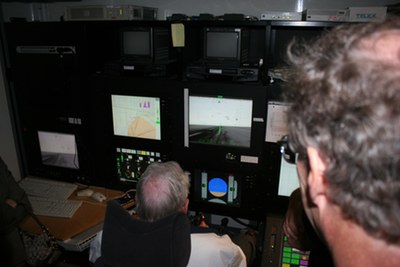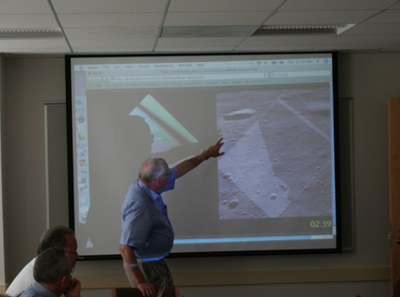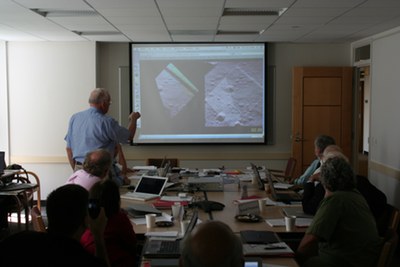Last thoughts about working with the First Manby Dwayne Day
|
| Some people labeled him a recluse, but the reality was that Neil Armstrong had no need to seek publicity and didn’t crave attention. |
As I grew up, like most boys I wanted to be an astronaut, then a fire fighter, then an astronaut. Neil and Buzz and a few others were my role models. Eventually my dreams of being an astronaut faded as I realized that bad eyesight and bad math grades would probably make that goal an impossible one. Some of the shine also came off the astronauts as I learned more about them. Buzz Aldrin’s first biography, Return to Earth, was an early example of an over-sharing celebrity. Buzz confessed to numerous faults in that book, including alcoholism and bouts of depression. After that, astronauts didn’t seem as impressive.
Then one evening in the early 1990s, while in graduate school studying space policy, I was at a space conference sitting in the back of a hotel ballroom when somebody sat down next to me. I glanced over to discover that it was Buzz Aldrin. A little later one of the speakers said something dumb and Buzz scoffed and told me what he thought of that. Buzz Aldrin is talking to me! I thought. But the thrill did not last very long, as I had more opportunities to run into Aldrin professionally. He may have been technically brilliant, but he often seemed to advocate space policy and technology ideas that simply weren’t practical, before moving on to other impractical ideas. Within space policy circles, nobody took him seriously. He also had a desperate need for attention and praise, doing every interview he could, slapping his name on every product he was asked to endorse, and showing up in the weirdest places and keeping the weirdest company.
But Neil Armstrong was not like that. Some people labeled him a recluse, but the reality was that Neil Armstrong had no need to seek publicity and didn’t crave attention. He was active on subjects that interested him, for instance, serving on the NASA Advisory Council’s aeronautics committee for several years. He just had no need for more publicity.
In late 2010 I was put in charge of a new study and solicited recommendations for people to serve on a committee that would look at NASA’s aeronautics flight research capabilities. Somebody suggested Neil Armstrong, and so I wrote him an email asking if he would be interested in serving on the committee. I got no response for a couple of weeks and forgot about it. Late one Sunday night an email arrived in my inbox. I did not immediately recognize the address and almost deleted it as spam. But when I opened it I realized that it was from Armstrong, expressing interest in my project. He had a few questions about it, including if it would prevent him from speaking publicly about space policy, which he had started doing earlier that year, surprising many people. He quickly signed up after I reassured him that he could continue his newly found space advocacy.
Our first project meeting was at NASA’s Dryden Flight Research Center at Edwards Air Force Base in spring 2011 and that’s where I first met him. What I quickly learned was that Armstrong was quiet. He didn’t speak much. He listened. I gradually got the sense that he was also a little hard of hearing, which led to him leaning toward whoever was speaking to him and tilting his head. At one point he referred to the time he worked as an astronaut as “going over to the Dark Side,” saying that he really preferred aircraft. Of course, Edwards had been his old stomping ground, and he had been there long before NASA’s facility was named Dryden.
| It was hard not to ascribe importance to even his smallest actions and think: Neil Armstrong uses a Mac Powerbook, or Neil Armstrong prefers Yahoo to Google, as if he was endorsing something simply by using it. |
At Dryden we got to tour various hangars and facilities and look at NASA research aircraft. At one point, while looking at the control van for the Ikhana unmanned aerial vehicle (NASA’s version of the military’s Predator drone), Armstrong sat at the controls and flew a simulated landing. After bringing the aircraft down to the runway a little hard, one of the instructor pilots joked “A good Navy landing!” a reference to naval aviators’ training to slam down onto the deck of aircraft carriers. Later we visited the famed Lockheed Skunk Works, getting the VIP treatment, probably because they knew who was in our midst. At one point I got out of an SUV we were traveling in to visit one of the locations. When I climbed back in, I noticed that instead of my previous passenger, Armstrong was sitting behind me, and for a moment I wondered if I had returned to the wrong vehicle. I must have given him a puzzled look, because he gave me a comical surprised look in return. Then he winked, one of his characteristic friendly expressions, and I broke out laughing.
 Armstrong at the controls of a simulator for NASA’s Ikhana UAV. (credit: D. Day) |
Over dinner at a Palmdale restaurant, I sat across from Armstrong who again didn’t talk much, but mostly listened to other people talk about aircraft and aeronautics research. At one point he mentioned how, when he was stationed at what was then called NASA’s High Speed Flight Station at Edwards Air Force Base in the early 1960s, he and a fellow test pilot regularly flew an F-4 Phantom up north, landing at some relatively obscure airfield that was capable of handling their jet. They had lunch at a restaurant at the airfield and then hopped in their jet and flew back to Edwards. To them it was little different than borrowing a car from the motor pool to go get a sandwich.
At one point we were discussing the Gary Powers shootdown and somebody mentioned how a CIA U-2 spyplane was quickly painted with NASA markings and shown to the press at Edwards. Armstrong said he had seen the whole dog and pony show—a witness to history long before he actually made history. When one member of our group asked him his favorite aircraft he didn’t hesitate. “F8F Bearcat,” he said. This was one of the first aircraft he flew after receiving his naval aviator’s wings. Unfortunately, we didn’t ask him why this was his favorite.
One of the few stories Armstrong told was how fellow test pilot Joe Walker was asked to fly in the Paris Air Show. Walker had a favorite F-104 aircraft with his name stenciled on it that nobody else was allowed to fly. Soon after Walker left for Europe, Armstrong was told to take Walker’s F-104 up for a test flight. He reluctantly agreed, taxied out onto the runway, started his takeoff roll, and the front tire blew out, immediately blowing rubber pieces into the intakes and destroying the engine. Fortunately, Armstrong was able to slow the plane down and then had to get it towed back to the hangar. Walker arrived back from Europe a few days later and walked into the hangar to see his beloved F-104 spread out in pieces on the floor for repair. “It took him a long time to forgive me!” Armstrong joked. He did not mention what some of us suspected: this may have been the same F-104 that Walker was killed in when he collided with the XB-70 in 1966.
Later, a member of our group mentioned Gemini 8 and Armstrong responded “Not many people know about Gemini 8.” Although I desperately wanted to hear him tell the story of how he had saved the spacecraft and both his and Dave Scott’s lives, I resisted. I was trying to be professional, not mixing work with my space history research. I thought that at some later point I might contact him and ask if I could interview him about Gemini 8. Alas, I never followed up.
| I don’t remember the first time that I watched Neil Armstrong land on the Moon, but I will never forget when he explained in person how he did it four decades later. |
We held several more meetings during the course of the year and I got to interact with Armstrong numerous times. He was always polite, and quiet. It was hard not to ascribe importance to even his smallest actions and think: Neil Armstrong uses a Mac Powerbook, or Neil Armstrong prefers Yahoo to Google, as if he was endorsing something simply by using it. At one point he handed me a sheet of paper with some notes on it and a printed “N. Armstrong” at the bottom and I was reminded that he never signed his name on anything. While these things might have seemed significant, at the end of the day, despite all the fame and the accomplishment, he was still just a guy. He liked airplanes, and golf, and he put his pants on one leg at a time just like the rest of us.
Despite his relative lack of interest in space, in the spring of 2010 Armstrong, along with Jim Lovell and Gene Cernan, wrote a letter expressing their concern with the state of American space policy. It was as if the faces carved into Mount Rushmore had suddenly started talking. This was one of the few times that Armstrong publicly went on record about space issues. People who did not like the letter and the Apollo astronauts’ skepticism about commercial spaceflight reacted negatively, some of them challenging the credentials of men who had not flown spacecraft in nearly four decades and had left NASA in the 1970s. Some of the comments on blogs and bulletin boards were bitter, and clearly some people felt like their heroes had let them down by not endorsing the things that they cared passionately about.
During 2011, the three Apollo veterans spoke up on the issue a few more times. One of our meetings followed one of their public pronouncements by a few days, and while we were meeting I noticed Armstrong reading a website that referred to their statement. I made an innocuous comment along the lines that some people had speculated that the letters were being ghost-written for them. I don’t remember Armstrong’s exact response, but he dismissed my statement out of hand. Although Armstrong was a man of few words, they were his words, not somebody else’s.
On the second to last day of our last meeting, at the end of August 2011, Armstrong asked if he could get up and show us something. I asked him to wait until we had finished a task. When we did, Armstrong plugged his laptop into a projector and got up to speak.
And that’s when he showed us how he landed on the Moon.
 Neil Armstrong describes the famous Apollo 11 landing during a meeting of an aeronautics committee in 2011. (credit: D. Day) |
What he had to show us was a video that somebody had sent him that Armstrong thought was impressive. Someone had taken the original Apollo 11 landing footage, filmed with a 16 mm camera mounted in the left window of the Lunar Module, and new imagery of the Apollo 11 landing site that had been collected by the Lunar Reconnaissance Orbiter (LRO) in orbit around the Moon. He had put the LRO images into a program that mapped them to a geometric figure of the lunar surface, just like Google Earth does with satellite imagery of the Earth. He had matched up the Apollo 11 footage exactly, placing the two side by side. The result was that you could watch it as if you were looking through both windows of the Lunar Module during the Apollo 11 landing. The LRO imagery, which was taken from approximately 50 kilometers above the lunar surface, is actually crisper than the Apollo footage, which was shot with a camera that had less power. Only in the last few seconds of the descent does the actual Apollo 11 footage show greater detail.
Armstrong narrated the video for us. He pointed out where the large boulders were that forced him to alter the trajectory. In the LRO images he pointed to the Lunar Module descent stage, which was visible as a blurry square, and said ,“That’s where I’m gonna land,” eliciting laughs from his audience. Some of his comments were nearly identical to his original comments during the actual descent, the one that I had first listened to as a toddler. For instance, he said “Here’s where I started kicking up some dust,” which brought smiles to more than a few faces.
There were no more than ten people in the room when he gave this presentation. We didn’t ask too many questions. I think we were all just thrilled to see it. We were probably among the first people to receive such a narrated briefing by Armstrong, although he later showed the video in front of Congress and during an Australian TV interview. I don’t remember the first time that I watched Neil Armstrong land on the Moon, but I will never forget when he explained in person how he did it four decades later.
When Armstrong died, his family released a statement that ended: “The next time you walk outside on a clear night and see the Moon smiling down at you, think of Neil Armstrong, and give him a wink.” That night I saw a blurry, not quite full Moon through the clouds where I lived. I winked.
Thank you, Neil. It was an honor to work with you.
